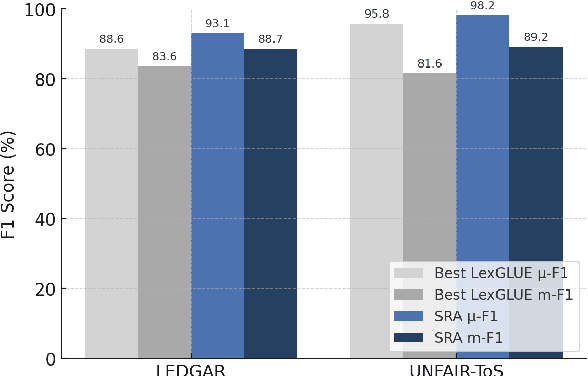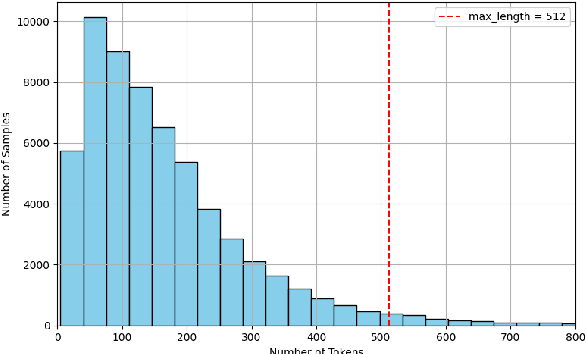Text Classification
Text classification is the process of categorizing text documents into predefined categories or labels.
Papers and Code
UMA-Split: unimodal aggregation for both English and Mandarin non-autoregressive speech recognition
Sep 18, 2025This paper proposes a unimodal aggregation (UMA) based nonautoregressive model for both English and Mandarin speech recognition. The original UMA explicitly segments and aggregates acoustic frames (with unimodal weights that first monotonically increase and then decrease) of the same text token to learn better representations than regular connectionist temporal classification (CTC). However, it only works well in Mandarin. It struggles with other languages, such as English, for which a single syllable may be tokenized into multiple fine-grained tokens, or a token spans fewer than 3 acoustic frames and fails to form unimodal weights. To address this problem, we propose allowing each UMA-aggregated frame map to multiple tokens, via a simple split module that generates two tokens from each aggregated frame before computing the CTC loss.
Text Adversarial Attacks with Dynamic Outputs
Sep 26, 2025Text adversarial attack methods are typically designed for static scenarios with fixed numbers of output labels and a predefined label space, relying on extensive querying of the victim model (query-based attacks) or the surrogate model (transfer-based attacks). To address this gap, we introduce the Textual Dynamic Outputs Attack (TDOA) method, which employs a clustering-based surrogate model training approach to convert the dynamic-output scenario into a static single-output scenario. To improve attack effectiveness, we propose the farthest-label targeted attack strategy, which selects adversarial vectors that deviate most from the model's coarse-grained labels, thereby maximizing disruption. We extensively evaluate TDOA on four datasets and eight victim models (e.g., ChatGPT-4o, ChatGPT-4.1), showing its effectiveness in crafting adversarial examples and its strong potential to compromise large language models with limited access. With a single query per text, TDOA achieves a maximum attack success rate of 50.81\%. Additionally, we find that TDOA also achieves state-of-the-art performance in conventional static output scenarios, reaching a maximum ASR of 82.68\%. Meanwhile, by conceptualizing translation tasks as classification problems with unbounded output spaces, we extend the TDOA framework to generative settings, surpassing prior results by up to 0.64 RDBLEU and 0.62 RDchrF.
Selective Retrieval-Augmentation for Long-Tail Legal Text Classification
Aug 28, 2025



Legal text classification is a fundamental NLP task in the legal domain. Benchmark datasets in this area often exhibit a long-tail label distribution, where many labels are underrepresented, leading to poor model performance on rare classes. This paper proposes Selective Retrieval-Augmentation (SRA) as a solution to this problem. SRA focuses on augmenting samples belonging to low-frequency labels in the training set, preventing the introduction of noise for well-represented classes, and requires no changes to the model architecture. Retrieval is performed only from the training data to ensure there is no potential information leakage, removing the need for external corpora simultaneously. The proposed SRA method is tested on two legal text classification benchmark datasets with long-tail distributions: LEDGAR (single-label) and UNFAIR-ToS (multi-label). The results indicate that SRA attains higher micro-F1 and macro-F1 scores compared to all current LexGLUE baselines across both datasets, illustrating consistent improvements in long-tail legal text classification.
Agent4FaceForgery: Multi-Agent LLM Framework for Realistic Face Forgery Detection
Sep 16, 2025Face forgery detection faces a critical challenge: a persistent gap between offline benchmarks and real-world efficacy,which we attribute to the ecological invalidity of training data.This work introduces Agent4FaceForgery to address two fundamental problems: (1) how to capture the diverse intents and iterative processes of human forgery creation, and (2) how to model the complex, often adversarial, text-image interactions that accompany forgeries in social media. To solve this,we propose a multi-agent framework where LLM-poweredagents, equipped with profile and memory modules, simulate the forgery creation process. Crucially, these agents interact in a simulated social environment to generate samples labeled for nuanced text-image consistency, moving beyond simple binary classification. An Adaptive Rejection Sampling (ARS) mechanism ensures data quality and diversity. Extensive experiments validate that the data generated by our simulationdriven approach brings significant performance gains to detectors of multiple architectures, fully demonstrating the effectiveness and value of our framework.
Optimizing Small Transformer-Based Language Models for Multi-Label Sentiment Analysis in Short Texts
Sep 05, 2025Sentiment classification in short text datasets faces significant challenges such as class imbalance, limited training samples, and the inherent subjectivity of sentiment labels -- issues that are further intensified by the limited context in short texts. These factors make it difficult to resolve ambiguity and exacerbate data sparsity, hindering effective learning. In this paper, we evaluate the effectiveness of small Transformer-based models (i.e., BERT and RoBERTa, with fewer than 1 billion parameters) for multi-label sentiment classification, with a particular focus on short-text settings. Specifically, we evaluated three key factors influencing model performance: (1) continued domain-specific pre-training, (2) data augmentation using automatically generated examples, specifically generative data augmentation, and (3) architectural variations of the classification head. Our experiment results show that data augmentation improves classification performance, while continued pre-training on augmented datasets can introduce noise rather than boost accuracy. Furthermore, we confirm that modifications to the classification head yield only marginal benefits. These findings provide practical guidance for optimizing BERT-based models in resource-constrained settings and refining strategies for sentiment classification in short-text datasets.
EgoInstruct: An Egocentric Video Dataset of Face-to-face Instructional Interactions with Multi-modal LLM Benchmarking
Sep 26, 2025Analyzing instructional interactions between an instructor and a learner who are co-present in the same physical space is a critical problem for educational support and skill transfer. Yet such face-to-face instructional scenes have not been systematically studied in computer vision. We identify two key reasons: i) the lack of suitable datasets and ii) limited analytical techniques. To address this gap, we present a new egocentric video dataset of face-to-face instruction and provide ground-truth annotations for two fundamental tasks that serve as a first step toward a comprehensive understanding of instructional interactions: procedural step segmentation and conversation-state classification. Using this dataset, we benchmark multimodal large language models (MLLMs) against conventional task-specific models. Since face-to-face instruction involves multiple modalities (speech content and prosody, gaze and body motion, and visual context), effective understanding requires methods that handle verbal and nonverbal communication in an integrated manner. Accordingly, we evaluate recently introduced MLLMs that jointly process images, audio, and text. This evaluation quantifies the extent to which current machine learning models understand face-to-face instructional scenes. In experiments, MLLMs outperform specialized baselines even without task-specific fine-tuning, suggesting their promise for holistic understanding of instructional interactions.
Image Recognition with Vision and Language Embeddings of VLMs
Sep 11, 2025Vision-language models (VLMs) have enabled strong zero-shot classification through image-text alignment. Yet, their purely visual inference capabilities remain under-explored. In this work, we conduct a comprehensive evaluation of both language-guided and vision-only image classification with a diverse set of dual-encoder VLMs, including both well-established and recent models such as SigLIP 2 and RADIOv2.5. The performance is compared in a standard setup on the ImageNet-1k validation set and its label-corrected variant. The key factors affecting accuracy are analysed, including prompt design, class diversity, the number of neighbours in k-NN, and reference set size. We show that language and vision offer complementary strengths, with some classes favouring textual prompts and others better handled by visual similarity. To exploit this complementarity, we introduce a simple, learning-free fusion method based on per-class precision that improves classification performance. The code is available at: https://github.com/gonikisgo/bmvc2025-vlm-image-recognition.
Diffusion-Based Cross-Modal Feature Extraction for Multi-Label Classification
Sep 19, 2025Multi-label classification has broad applications and depends on powerful representations capable of capturing multi-label interactions. We introduce \textit{Diff-Feat}, a simple but powerful framework that extracts intermediate features from pre-trained diffusion-Transformer models for images and text, and fuses them for downstream tasks. We observe that for vision tasks, the most discriminative intermediate feature along the diffusion process occurs at the middle step and is located in the middle block in Transformer. In contrast, for language tasks, the best feature occurs at the noise-free step and is located in the deepest block. In particular, we observe a striking phenomenon across varying datasets: a mysterious "Layer $12$" consistently yields the best performance on various downstream classification tasks for images (under DiT-XL/2-256$\times$256). We devise a heuristic local-search algorithm that pinpoints the locally optimal "image-text"$\times$"block-timestep" pair among a few candidates, avoiding an exhaustive grid search. A simple fusion-linear projection followed by addition-of the selected representations yields state-of-the-art performance: 98.6\% mAP on MS-COCO-enhanced and 45.7\% mAP on Visual Genome 500, surpassing strong CNN, graph, and Transformer baselines by a wide margin. t-SNE and clustering metrics further reveal that \textit{Diff-Feat} forms tighter semantic clusters than unimodal counterparts. The code is available at https://github.com/lt-0123/Diff-Feat.
Target-oriented Multimodal Sentiment Classification with Counterfactual-enhanced Debiasing
Sep 11, 2025Target-oriented multimodal sentiment classification seeks to predict sentiment polarity for specific targets from image-text pairs. While existing works achieve competitive performance, they often over-rely on textual content and fail to consider dataset biases, in particular word-level contextual biases. This leads to spurious correlations between text features and output labels, impairing classification accuracy. In this paper, we introduce a novel counterfactual-enhanced debiasing framework to reduce such spurious correlations. Our framework incorporates a counterfactual data augmentation strategy that minimally alters sentiment-related causal features, generating detail-matched image-text samples to guide the model's attention toward content tied to sentiment. Furthermore, for learning robust features from counterfactual data and prompting model decisions, we introduce an adaptive debiasing contrastive learning mechanism, which effectively mitigates the influence of biased words. Experimental results on several benchmark datasets show that our proposed method outperforms state-of-the-art baselines.
Using LLMs for Multilingual Clinical Entity Linking to ICD-10
Sep 05, 2025The linking of clinical entities is a crucial part of extracting structured information from clinical texts. It is the process of assigning a code from a medical ontology or classification to a phrase in the text. The International Classification of Diseases - 10th revision (ICD-10) is an international standard for classifying diseases for statistical and insurance purposes. Automatically assigning the correct ICD-10 code to terms in discharge summaries will simplify the work of healthcare professionals and ensure consistent coding in hospitals. Our paper proposes an approach for linking clinical terms to ICD-10 codes in different languages using Large Language Models (LLMs). The approach consists of a multistage pipeline that uses clinical dictionaries to match unambiguous terms in the text and then applies in-context learning with GPT-4.1 to predict the ICD-10 code for the terms that do not match the dictionary. Our system shows promising results in predicting ICD-10 codes on different benchmark datasets in Spanish - 0.89 F1 for categories and 0.78 F1 on subcategories on CodiEsp, and Greek - 0.85 F1 on ElCardioCC.
 Add to Chrome
Add to Chrome Add to Firefox
Add to Firefox Add to Edge
Add to Edge